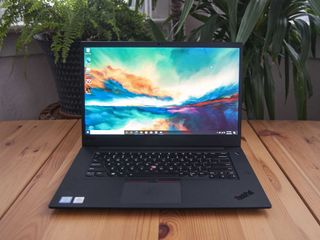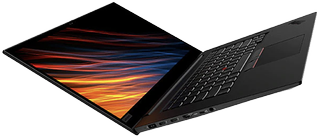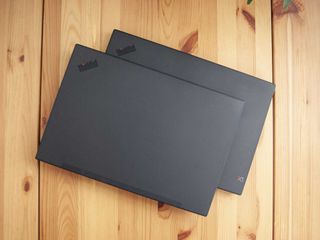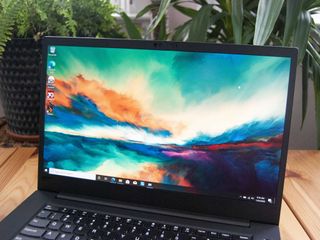
Lenovo's attack on the 15-inch powerhouse Ultrabook market includes both the second-gen ThinkPad X1 Extreme and ThinkPad P1, two devices that are almost identical yet are geared for different usage scenarios. I recently reviewed the X1 Extreme (Gen 2), ultimately handing it a Best Award thanks to its balance of design, features, and performance.
While the X1 Extreme's internal hardware is more geared toward the average user who likes extra power, the ThinkPad P1 (Gen 2) counterpart is a truer mobile workstation with internal hardware meant to work with specialized professional software. I made the switch to the P1 more than a week ago to test it out and decided that a standard full review would be redundant. Instead, I'll highlight some of the configuration differences and performance levels to help highlight what the P1 does better than the X1 Extreme.
This laptop doesn't come cheap, and you might be able to find a great deal during Black Friday sales. Just be sure Lenovo isn't also offering up some tasty deals of its own; deep coupon discounts are often applied at the official retailer. We've seen models with a Core i7 CPU, 16GB of RAM, 256GB SSD, and NVIDIA Quadro T1000 dedicated GPU go for somewhere around $1,760 at Amazon, so be sure you're getting a better deal than that during Black Friday.

Mobile workstation sibling to the X1 Extreme
Lenovo's second-gen ThinkPad P1 has the option for specialized hardware meant to handle specific design and development hardware.
Lenovo ThinkPad P1 (Gen 2) at a glance

Lenovo supplied Windows Central with a review unit of the second-gen ThinkPad P1. This exact model includes a 9th Gen Intel Core i7-9850H vPro processor (CPU), 32GB of DDR4-2666MHz RAM, a 2TB M.2 PCIe solid-state drive (SSD), NVIDIA Quadro T2000 dedicated graphics card (GPU) with 4GB of GDDR5 VRAM, and a 4K non-touch IPS display. This exact model costs almost $4,000 before any discounts, coming down to about $2,824 with the usual Lenovo coupon add-ons. An Intel Xeon E-2276M CPU and ECC RAM can be added for those who need it, though you will understandably pay more.
To put the price into perspective, a similar X1 Extreme model with a NVIDIA GTX 1650 Max-Q GPU and 1TB M.2 SSD costs almost $600 more as configured, though Lenovo's coupon add-ons bring it down to about $2,628. Considering these two laptops are almost physically identical, it's good that Lenovo is attempting to keep prices almost the same for similar internal hardware. If you want specialized hardware you'll pay more, but otherwise there's not much difference.
Like the X1 Extreme, the P1 has upgradeable SSD and RAM to help keep it relevant longer into the future. You can purchase a high-end CPU and cut costs on supporting hardware, only to upgrade yourself when you find a good deal. If you'd rather just buy straight from the factory and not worry about any DIY upgrades, Lenovo offers a ton of customization options.
Here's a detailed breakdown of the specs found in our review units of both the ThinkPad P1 and ThinkPad X1 Extreme.
Get the Windows Central Newsletter
All the latest news, reviews, and guides for Windows and Xbox diehards.
| Category | ThinkPad P1 | ThinkPad X1 Extreme |
|---|---|---|
| OS | Windows 10 Pro | Windows 10 Pro |
| Processor | 9th Gen Intel Core i7-9850H vPro Up to 4.6GHz Six cores | 9th Gen Intel Core i7-9850H vPro Six cores Up to 4.6GHz |
| RAM | 32GB DDR4-2666MHz Dual channel | 32GB DDR4-2666MHz Dual channel |
| Graphics | NVIDIA Quadro T2000 4GB GDDR5 VRAM | NVIDIA GTX 1650 Max-Q 4GB GDDR5 VRAM |
| Storage | 2TB M.2 PCIe SSD RAID 0/1 support for dual SSDs | 1TB M.2 PCIe SSD RAID 0/1 support for dual M.2 SSDs |
| Display | 15.6 inches 3840x2160 (UHD) IPS, non-touch, matte Dolby Vision HDR | 15.6 inches 3840x2160 (UHD) OLED, Touch Dolby Vision HDR |
| Ports | Two USB-A 3.1 Two Thunderbolt 3 HDMI 2.0 Ethernet extension connector 3.5mm audio UHS-II SD card reader | Two USB-A 3.1 Two Thunderbolt 3 HDMI 2.0 Ethernet extension connector 3.5mm audio UHS-II SD card reader |
| Audio | Dual 2W speakers Dolby Atmos | Dual 2W speakers Dolby Atmos |
| Wireless | Intel Wireless-AX200 (2x2) 802.11ax (Wi-Fi 6) Bluetooth 5.0 | Intel Wireless-AX200 (2x2) 802.11ax (Wi-Fi 6) Bluetooth 5.0 |
| Camera | Front-facing 720p | Front-facing 720p |
| Security | Smart Card reader (optional) IR camera ThinkShutter webcam cover dTPM 2.0 Fingerprint reader | Smart Card reader (optional) ThinkShutter webcam cover IR camera dTPM 2.0 Fingerprint reader |
| Touchpad | Precision TrackPoint system | Precision TrackPoint system |
| Battery | 80Wh 135W AC adapter | 80Wh 135W AC adapter |
| Dimensions | 14.24 x 9.67 x 0.74 inches (361.8mm x 245.7mm x 18.7mm) | 14.24 x 9.67 x 0.74 inches (361.8mm x 245.7mm x 18.7mm) |
| Weight | Non-touch: 3.75 pounds (1.7kg) Touch: 4.0 pounds (1.81kg) | Non-touch: 3.75 pounds (1.7kg) Touch: 4.0 pounds (1.81kg) |
Comparing Lenovo's ThinkPad P1 and X1 Extreme


Sitting closed side by side, the X1 Extreme and P1 are physically identical save for the small X1 branding on the lid of the former device. I won't go into too many details about the design since I already wrote about the X1 Extreme, but know that the P1 uses the same aluminum alloy for the main chassis, it has the same carbon fiber finish on the lid, and it has undergone the same MIL-STD 810G durability testing.
The ThinkPad P1 comes with the same perks as the formidable X1 Extreme, but it's far better cut out for specialized work.
Ports are also exactly the same, offering up solid connectivity with dual Thunderbolt 3, HDMI, dual USB-A 3.1, and an SD card reader handling the brunt of peripherals. There's still a speedy fingerprint reader to the right of the keyboard for extra security on top of the IR camera for facial recognition. Dimensions and weight are exactly the same between both laptops.
While the X1 Extreme review unit includes an OLED 4K touch display with edge-to-edge glass, the P1 review unit has a non-touch 4K IPS display with matte finish. Instead of the edge-to-edge glass that covers the bezel, there's a fiber hybrid surround that's slightly raised. There's still a front-facing 720p camera and IR camera built into the top bezel, complete with a privacy ThinkShutter cover. This display can also be had on the X1 Extreme, as can the OLED display be configured into the P1. Lenovo simply sent me different builds for a bit of variety.
Whereas the OLED display option offers 100% DCI-P3, 100% sRGB, and 100% AdobeRGB, color gamut coverage, the 4K IPS option brings 100% sRGB, 100% AdobeRGB, and about 86% DCI-P3. If you need accurate DCI-P3 coverage for the work at hand you'll no doubt want to shell out the extra money for the OLED model, but otherwise the 4K IPS display is still a great option. If you don't need 4K at all, the P1 has two FHD display options, one with and one without Dolby Vision HDR 400.

One major benefit of the non-OLED, non-touch 4K display in the P1 is a boost to battery life. I ran PCMark's video rundown test simultaneously on both laptops to get an idea of the power draw when not running any heavy programs. Unsurprisingly, the P1 managed to hit five hours and 51 minutes, while the X1 Extreme hit four hours and 29 minutes. Whether you choose the P1 or X1 Extreme, you're going to get a significant boost to battery life by foregoing the OLED option.
Part of the second-gen improvements in the P1 is a move to NVIDIA Quadro T1000 or T2000 dedicated GPUs. Compared to the NVIDIA GTX 1650 in the X1 Extreme, the Quadro hardware is designed to handle specialized workloads in the professional sector. If you're working with software like AutoCAD, Revit, and SolidWorks, you're likely going to want to opt for the P1. It also comes with numerous ISV certifications that guarantee the system is going to perform optimally when handling this type of work.
Both laptops can be configured with up to a 9th Gen Intel Core i9-9880H vPro CPU, but only the P1 has the additional option for an Intel Xeon E-2276M vPro CPU. Like the NVIDIA Quadro, Xeon hardware is designed specifically to handle specialized work. I ran some benchmarks to see how well the second-gen ThinkPad P1 compares to the X1 Extreme and some other laptops we've recently reviewed.
CPU
Geekbench 5.0 Benchmarks (Higher is better)
| Device | CPU | Single core | Multi core |
|---|---|---|---|
| Lenovo ThinkPad P1 (Gen 2) | i7-9850H | 1,233 | 5,216 |
| Lenovo ThinkPad X1 Extreme (Gen 2) | i7-9850H | 1,160 | 4,168 |
| Dynabook Portégé X30-F | i7-8665U | 1,236 | 3,473 |
| Dynabook Tecra X50-F | i7-8665U | 1,241 | 3,043 |
| Dell Inspiron 13 7390 2-in-1 | i7-8565U | 1,111 | 2,965 |
| Lenovo ThinkPad P53 | Xeon E-2276M | 1,237 | 6,152 |
| Surface Laptop 3 13.5 | Core i5-1035G7 | 1,177 | 4,413 |
| Dell XPS 13 2-in-1 7390 | Core i7-1065G7 | 1,209 | 3,571 |
| Surface Laptop 3 15 | Ryzen 5 | 769 | 2,720 |
| Dell XPS 15 7590 | Core i9-9980HK | 1,176 | 7,624 |
Same CPU, better raw performance seen in single- and multi-core scores in the ThinkPad P1.
PCMark
PCMark 10 Express
| Device | Score |
|---|---|
| Lenovo ThinkPad P1 (Gen 2) | 4,969 |
| Lenovo ThinkPad X1 Extreme (Gen 2) | 4,915 |
| Dynabook Portégé X30-F | 3,881 |
| Dynabook Tecra X50-F | 4,128 |
| Dell Inspiron 13 7390 2-in-1 | 3,764 |
| Lenovo ThinkPad P53 | 5,668 |
| Surface Laptop 3 15 (AMD) | 4,006 |
| Dell XPS 15 7590 | 5,521 |
| Dell Precision 3541 | 3,906 |
The PCMark 10 Express test measures how well the system performs with general tasks, while the Extended version adds in some heavier work. The P1 scored 4,980 in the extended test, while the X1 Extreme managed 4,850.
3DMark
Time Spy
| Device | GPU | Score |
|---|---|---|
| Lenovo ThinkPad P1 (Gen 2) | Quadro T2000 | 2,956 |
| Lenovo ThinkPad X1 Extreme (Gen 2) | GTX 1650 Max-Q | 3,190 |
| Lenovo ThinkPad P53 | Quadro RTX 5000 | 6,760 |
| Lenovo Legion Y740 15 | RTX 2070 Max-Q | 6,406 |
| Lenovo Legion Y740 17 | RTX 2080 Max-Q | 7,128 |
3DMark
Fire Strike
| Device | GPU | Score |
|---|---|---|
| Lenovo ThinkPad P1 (Gen 2) | Quadro T2000 | 6,632 |
| Lenovo ThinkPad X1 Extreme (Gen 2) | GTX 1650 Max-Q | 7,198 |
| Dell XPS 15 (7590) | GTX 1650 Max-Q | 7,763 |
| Lenovo ThinkPad P53 | Quadro RTX 5000 | 16,367 |
| Lenovo Legion Y740 15 | RTX 2070 Max-Q | 14,669 |
| Lenovo Legion Y740 17 | RTX 2080 Max-Q | 16,303 |
| Razer Blade 15 | GTX 1070 | 13,560 |
Cinebench
Cinebench (R20) (Higher is better)
| Device | CPU | Range |
|---|---|---|
| Lenovo ThinkPad P1 (Gen 2) | Core i7-9850H | 1,783 to 2,201 |
| Lenovo ThinkPad X1 Extreme (Gen 2) | Core i7-9850H | 1,730 to 2,495 |
| Dynabook Portégé X30-F | Core i7-8665U | 1,242 to 1,313 |
| Lenovo ThinkPad P53 | Xeon E-2276M | 2,686 to 2,701 |
| Surface Laptop 3 13.5 | Core i5-1035G4 | 1,584 to 1,606 |
| Surface Laptop 3 15 | Core i7-1065G7 | 1,703 to 1,745 |
Running Cinebench four times in a row, the scores show the following ranges. Typically, the results drop on successive runs due to thermal constraints on the processor.
SSD
CrystalDiskMark (Higher is better)
| Device | Read | Write |
|---|---|---|
| Lenovo ThinkPad P1 (Gen 2) | 3,508 MB/s | 3,010 MB/s |
| Lenovo ThinkPad X1 Extreme (Gen 2) | 3,416 MB/s | 3,016 MB/s |
| Dynabook Portégé X30-F | 529 MB/s | 348 MB/s |
| Dynabook Tecra X50-F | 3,400 MB/s | 1,952 MB/s |
| Lenovo ThinkPad P53 | 3,567.23 MB/s | 2,813.25 MB/s |
| Lenovo ThinkPad P52 | 3,120 MB/s | 1,551.5 MB/s |
| Dell XPS 15 7590 | 3,000 MB/s | 2,796 MB/s |
| MSI PS63 Modern | 3,300 MB/s | 1,875 MB/s |
The Samsung PM981 found here delivers extremely quick read and write speeds, and hardware can be upgraded down the road. Testing with PCMark's data drive benchmark, I saw a score of 2,119.
Should you buy Lenovo's ThinkPad P1?

There's not a lot to dislike about the X1 Extreme or the P1. The same minor gripes about battery life and relatively thick bezel apply here, but they're certainly not deal-breakers. If you don't need Intel Xeon and NVIDIA Quadro hardware for your workload, there's really no reason to opt for the P1 unless there's some sort of sale that sets it at a cheaper price than the X1 Extreme. The NVIDIA GTX 1650 GPU is better cut out for the average user, and you won't be paying the extra bucks for ISV certifications that are no doubt tucked in somewhere.
Both laptops have an outstanding keyboard, ports are identical, and the same display options are available. Both bring a combination of durability, security features, and performance in a thin body that's just plain fun to use. Be sure to check out our full review of the X1 Extreme (Gen 2) for grittier details that apply to both laptops. If neither of these laptops is quite what you're looking for, head over to our best Windows laptop roundup for far more options.

Mobile workstation version of the X1 Extreme
Lenovo's second-gen ThinkPad P1 has the option for specialized hardware meant to handle specific design and development hardware.

Cale Hunt brings to Windows Central more than eight years of experience writing about laptops, PCs, accessories, games, and beyond. If it runs Windows or in some way complements the hardware, there’s a good chance he knows about it, has written about it, or is already busy testing it.